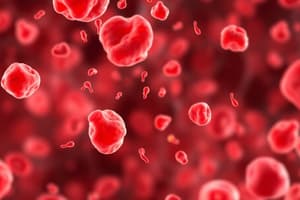Podcast
Questions and Answers
What is the effect of Vitamin B12 deficiency on the serum levels of methylmalonic acid?
What is the effect of Vitamin B12 deficiency on the serum levels of methylmalonic acid?
- It significantly increases methylmalonic acid levels. (correct)
- It has no effect on methylmalonic acid levels.
- It causes erratic fluctuations in methylmalonic acid levels.
- It decreases methylmalonic acid levels.
How can reticulocyte count assist in diagnosing normocytic anemia?
How can reticulocyte count assist in diagnosing normocytic anemia?
- A reticulocyte count greater than 3% signifies increased destruction of RBCs. (correct)
- Low reticulocyte count suggests high hemolysis rate.
- Normal reticulocyte count indicates acute blood loss.
- Higher reticulocyte count indicates reduced RBC destruction.
Which condition is associated with predominant extravascular hemolysis in normocytic anemia?
Which condition is associated with predominant extravascular hemolysis in normocytic anemia?
- Microangiopathic hemolytic anemia
- Sickle cell anemia (correct)
- Immune hemolytic anemia
- Paroxysmal nocturnal hemoglobinuria
What is the consequence of renal failure related to normocytic anemia?
What is the consequence of renal failure related to normocytic anemia?
Which of the following lab findings is characteristic of normocytic anemia due to poor bone marrow response?
Which of the following lab findings is characteristic of normocytic anemia due to poor bone marrow response?
What additional condition could complicate transient erythroblastopenia caused by Parvovirus B19?
What additional condition could complicate transient erythroblastopenia caused by Parvovirus B19?
What are common symptoms associated with anemia?
What are common symptoms associated with anemia?
Which laboratory finding is typically high in patients with folate deficiency anemia?
Which laboratory finding is typically high in patients with folate deficiency anemia?
Which of the following molecules plays a key role in iron transport?
Which of the following molecules plays a key role in iron transport?
Which type of anemia results from deficiencies in folate or vitamin B12?
Which type of anemia results from deficiencies in folate or vitamin B12?
What is the clinical representation of iron deficiency anemia?
What is the clinical representation of iron deficiency anemia?
Which cytokines are commonly associated with anemia of chronic disease?
Which cytokines are commonly associated with anemia of chronic disease?
What lab finding is expected in a patient with sideroblastic anemia?
What lab finding is expected in a patient with sideroblastic anemia?
How does parvovirus B19 affect the reticulocyte count?
How does parvovirus B19 affect the reticulocyte count?
Which condition is characterized by a reduction of RBC total mass?
Which condition is characterized by a reduction of RBC total mass?
What is the primary role of vitamin B12 in the body?
What is the primary role of vitamin B12 in the body?
What condition often leads to vitamin B12 deficiency due to intrinsic factor reduction?
What condition often leads to vitamin B12 deficiency due to intrinsic factor reduction?
What is the most common outcome of vitamin B12 deficiency?
What is the most common outcome of vitamin B12 deficiency?
Which factor is NOT associated with the absorption of vitamin B12?
Which factor is NOT associated with the absorption of vitamin B12?
Which of the following findings is characteristic of megaloblastic anemia due to vitamin B12 deficiency?
Which of the following findings is characteristic of megaloblastic anemia due to vitamin B12 deficiency?
Which condition can interfere with vitamin B12 absorption due to damage to the terminal ileum?
Which condition can interfere with vitamin B12 absorption due to damage to the terminal ileum?
What type of cells are often seen in the peripheral blood of patients with vitamin B12 deficiency?
What type of cells are often seen in the peripheral blood of patients with vitamin B12 deficiency?
Which biochemical process requires vitamin B12 as a cofactor?
Which biochemical process requires vitamin B12 as a cofactor?
Which group is at the highest risk of dietary deficiency of vitamin B12?
Which group is at the highest risk of dietary deficiency of vitamin B12?
What laboratory finding is typically seen with vitamin B12 deficiency?
What laboratory finding is typically seen with vitamin B12 deficiency?
Flashcards
What is Anemia?
What is Anemia?
Anemia is a condition characterized by a reduced total mass of red blood cells (RBCs). It is commonly identified through low hemoglobin levels and leads to symptoms caused by insufficient oxygen delivery, including weakness, fatigue, shortness of breath, and pale skin.
What is the corpuscular volume-based anemia classification?
What is the corpuscular volume-based anemia classification?
The corpuscular volume-based classification for the various types of anemias utilizes the Mean Corpuscular Volume (MCV) to distinguish between different forms of anemia based on the average size of red blood cells.
Describe the process of iron metabolism.
Describe the process of iron metabolism.
Iron metabolism, crucial for red blood cell production, involves a complex process with key molecules like ferroportin, hepcidin, transferrin, and ferritin responsible for iron absorption, transport, storage, and utilization.
What is the main cause of Iron Deficiency Anemia?
What is the main cause of Iron Deficiency Anemia?
Signup and view all the flashcards
How does anemia of chronic disease develop?
How does anemia of chronic disease develop?
Signup and view all the flashcards
Describe the process of sideroblastic anemia.
Describe the process of sideroblastic anemia.
Signup and view all the flashcards
Explain the origin of megaloblastic anemia.
Explain the origin of megaloblastic anemia.
Signup and view all the flashcards
What are the non-hematologic consequences of vitamin B12 deficiency?
What are the non-hematologic consequences of vitamin B12 deficiency?
Signup and view all the flashcards
What is the cause of Normocytic anemia due to red blood cell underproduction?
What is the cause of Normocytic anemia due to red blood cell underproduction?
Signup and view all the flashcards
Vitamin B12
Vitamin B12
Signup and view all the flashcards
Pernicious Anemia
Pernicious Anemia
Signup and view all the flashcards
Haptocorrin
Haptocorrin
Signup and view all the flashcards
Intrinsic Factor
Intrinsic Factor
Signup and view all the flashcards
Pancreatic insufficiency
Pancreatic insufficiency
Signup and view all the flashcards
Symptoms of B12 deficiency
Symptoms of B12 deficiency
Signup and view all the flashcards
Macrocytic Anemia
Macrocytic Anemia
Signup and view all the flashcards
Hypersegmented Neutrophils
Hypersegmented Neutrophils
Signup and view all the flashcards
Subacute Combined Degeneration of the Spinal Cord
Subacute Combined Degeneration of the Spinal Cord
Signup and view all the flashcards
Methylmalonic Acid Conversion
Methylmalonic Acid Conversion
Signup and view all the flashcards
Methylmalonic Acidemia
Methylmalonic Acidemia
Signup and view all the flashcards
Hemolysis
Hemolysis
Signup and view all the flashcards
Extravascular Hemolysis
Extravascular Hemolysis
Signup and view all the flashcards
Intravascular Hemolysis
Intravascular Hemolysis
Signup and view all the flashcards
Normocytic Anemia
Normocytic Anemia
Signup and view all the flashcards
Reticulocytes
Reticulocytes
Signup and view all the flashcards
Study Notes
Red Blood Cell Disorders
- Red blood cell (RBC) disorders encompass a variety of conditions affecting the structure, function, or production of red blood cells.
- These disorders can result in decreased oxygen-carrying capacity, leading to a range of clinical manifestations.
- The clinical significance of abnormal values like mean corpuscular volume (MCV), mean corpuscular hemoglobin (MCH), mean corpuscular hemoglobin concentration (MCHC), ferritin, total iron-binding capacity (TIBC) and transferrin saturation (TSAT) is important to assess these conditions.
- Anemia is characterized by a reduced total RBC mass. This leads to hypoxia-related symptoms and signs, including weakness, dyspnea, fatigue, pale skin, lips and conjunctiva, headache, lightheadedness and myocardial ischemia.
- The difficulty in directly measuring total RBC mass led to the development of surrogate markers, including blood hemoglobin levels and hematocrit values.
- Additional, common laboratory values include mean corpuscular volume (MCV), mean corpuscular hemoglobin (MCH), & mean corpuscular hemoglobin concentration (MCHC).
- Serum transferrin is increased in iron deficiency & in response to steroids.
- Serum ferritin is a marker evaluating iron stores.
- Red cell distribution width (RDW) is the coefficient of variation of red cell volume.
- Anemia (based on MCV): microcytic, macrocytic and normocytic anemias. These classifications differ based on size and other cellular characteristics.
- Microcytic anemias are characterized by reduced Hb production and are due to deficiencies of iron and protoporphyrin.
- Macrocytic anemias are characterized by impaired division and enlargement of RBC precursors due to deficiency in Folate or Vitamin B12.
- Normocytic anemias can result from increased destruction or reduced production of RBCs.
- Common causes of anemia include iron deficiency, chronic blood loss, anemia of chronic disease (inflammation), thalassemia, RBC destruction/hemolysis, and reduced RBC production.
- The specific causes and types of anemia affect patient presentation and treatment.
Iron Deficiency Anemia
- Iron deficiency anemia is the most common nutritional deficiency worldwide.
- The main causes of iron deficiency anemia are inadequate intake, impaired iron absorption, increased iron requirements, or chronic blood loss.
- Impaired absorption can be due to fat malabsorption, post-gastrectomy, malabsorption syndromes, or inhibition by tannins, carbonates, oxalates, and phosphates in the diet. Increased requirements can occur during growth, pregnancy or blood loss.
- Stages in iron deficiency anemia include depletion of iron storage, iron deficient erythropoiesis, and iron deficiency anemia.
- Lab findings for iron deficiency anemia include low hemoglobin and hematocrit, low MCV and MCHC, low serum ferritin, and elevated total iron-binding capacity (TIBC).
- Microscopic findings show microcytic and hypochromic RBCs, diminished stainable iron within macrophages in bone marrow, and potential presence of poikilocytosis (e.g., pencil cells).
Anemia of Chronic Disease
- Anemia of chronic disease, also known as anemia of inflammation, is a common type of anemia.
- It is often associated with chronic inflammatory conditions such as infections, autoimmune diseases, cancers, and chronic kidney diseases.
- The mechanism behind the anemia involves the body's inflammatory response, where certain inflammatory mediators such as IL-6 stimulate the production of more hepcidin, inhibiting iron release and availability for erythropoiesis.
- Lab findings for anemia of chronic disease include low serum iron, decreased iron-binding capacity and slightly increased serum ferritin, which are in contrast to iron deficiency anemia.
- This can lead to the reduced production of RBCs.
Sideroblastic Anemia
- Sideroblastic anemia is an anemia type defined by abnormal iron metabolism within the bone marrow.
- The key characteristic is the presence of ringed sideroblasts, which are erythroblasts with iron-laden mitochondria.
- Causes include hereditary defects in the enzymes involved in porphyrin synthesis and acquired causes such as alcohol abuse, lead poisoning, and Vitamin B6 deficiency.
- Laboratory findings include increased serum iron, increased ferritin and transferrin saturation. In addition, microcytic hypochromic and dimorphic RBCs may appear; bone marrow biopsy may reveal ringed sideroblasts.
Thalassemia
- Thalassemia is a group of inherited blood disorders.
- It is characterized by a reduced or absent synthesis of one or more globin chains to create hemoglobin (Hb).
- The decreased synthesis of globin chains leads to ineffective red blood cell production.
Macrocytic Anemia
- Macrocytic anemia is a type of anemia characterized by a larger than normal mean corpuscular volume (MCV) of the red blood cells.
- It arises from impaired division and enlargement of RBC precursors leading to megaloblastic anemia (large red blood cells).
- Common causes include deficiency in vitamin B12 or folate. Deficiencies in these vitamins interrupt the conversion of homocysteine to methionine (for vitamin B12), or deoxythymidylate monophosphate to thymidine (with both vitamins).
- Other causes (without megaloblastic changes) include drug use, alcoholism or severe liver cirrhosis.
- Microscopic findings include macrocytic RBCs with hypersegmented neutrophils, glossitis, low serum vitamin, and folate. High serum homocysteine is also a possibility.
Vitamin B12 Deficiency
- Vitamin B12 is a water-soluble vitamin essential for various bodily functions, including DNA synthesis and neurological function.
- It's primarily absorbed in the ileum. It is bound to proteins in foods and released for absorption by salivary enzymes. Once freed, it binds to intrinsic factor to be absorbed into the body.
- The most common cause is pernicious anemia, an autoimmune disorder targeting parietal cells that produce intrinsic factor, preventing absorption.
- Other causes include impaired absorption due to issues of terminal ileum, pancreatic insufficiency, and dietary deficiency (e.g. vegans).
- Deficiency can lead to neurological damage. Lab and clinical findings include low vitamin B12, high methylmalonic acid levels, and elevated serum homocysteine.
Normocytic Anemia
- Normocytic anemias are characterized by a normal-sized red blood cell volume (MCV).
- It can result from hemolysis, reduced production, or acute blood loss.
- One important distinguishing factor to help determine the cause is the reticulocyte count. An increased count (>3%) correlates with hemolysis, since the bone marrow is producing more RBCs.
- Causes include anemia due to reduced production (renal failure/low EPO, aplastic anemia), hemolytic anemias (inherited or acquired), and acute blood loss.
Anemia Due to Reduced RBC Production
- Causes include renal failure, where bone marrow erythroid precursors affected by reduced erythropoietin (EPO) production and results in a lower reticulocyte count.
- Other underlying conditions that can result in reduced erythropoietin include hepatocellular disease, autoimmune disorders, alcohol abuse and bleeding tendencies.
Parvovirus B19
- Parvovirus B19 is a small DNA virus affecting humans.
- A key infection site is the erythroid progenitor cells.
- Infection with B19 can cause aplastic crisis & erythroblastopenia.
- Anemia only occurs with significant reduction in RBCs.
Studying That Suits You
Use AI to generate personalized quizzes and flashcards to suit your learning preferences.




